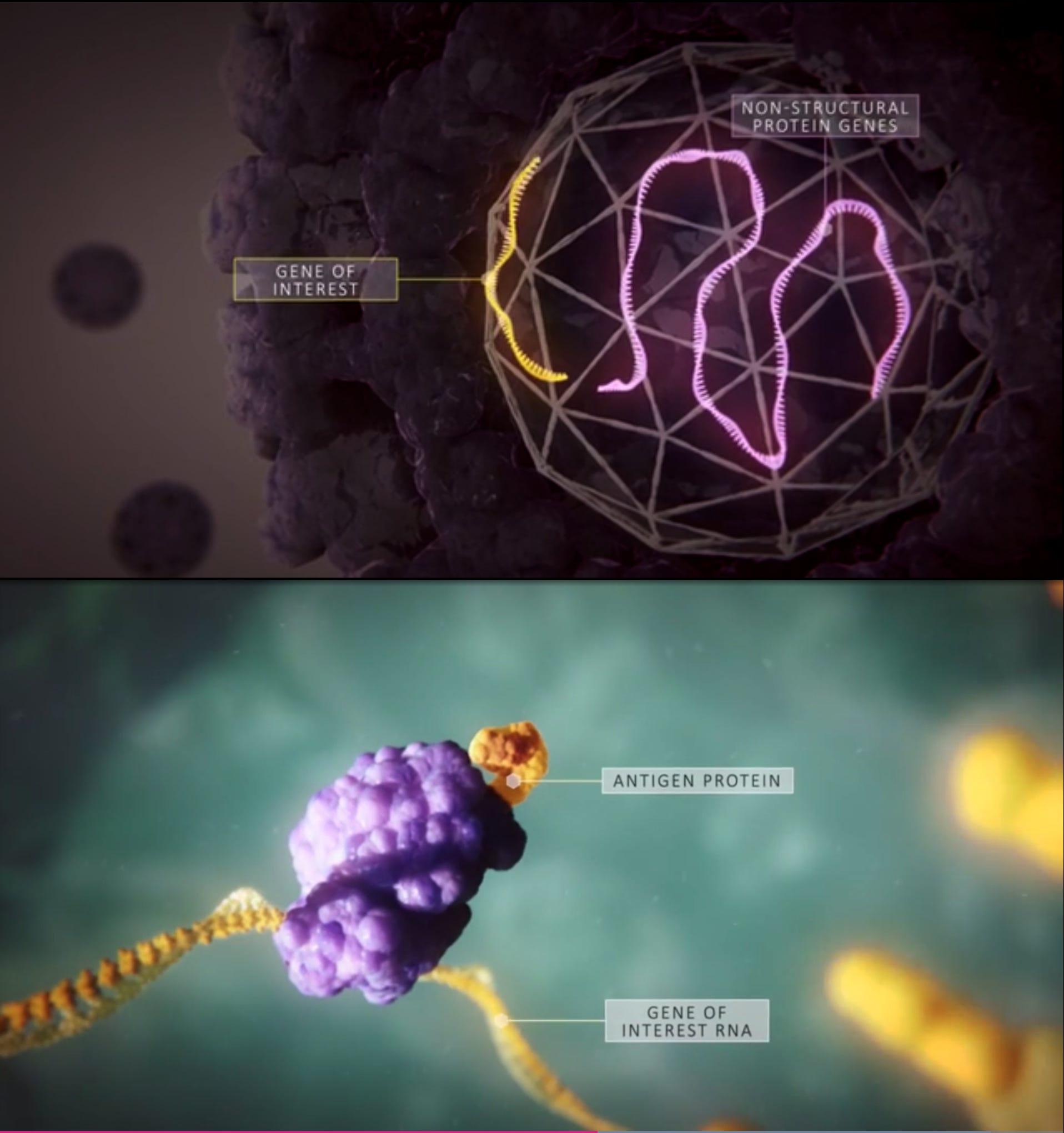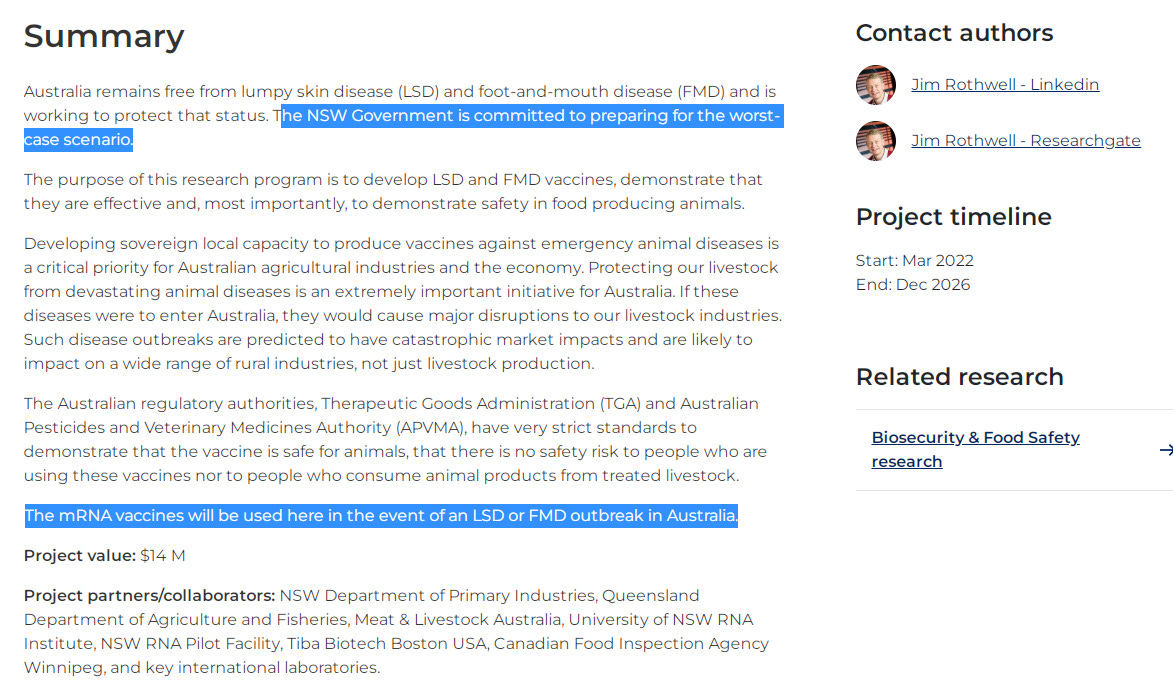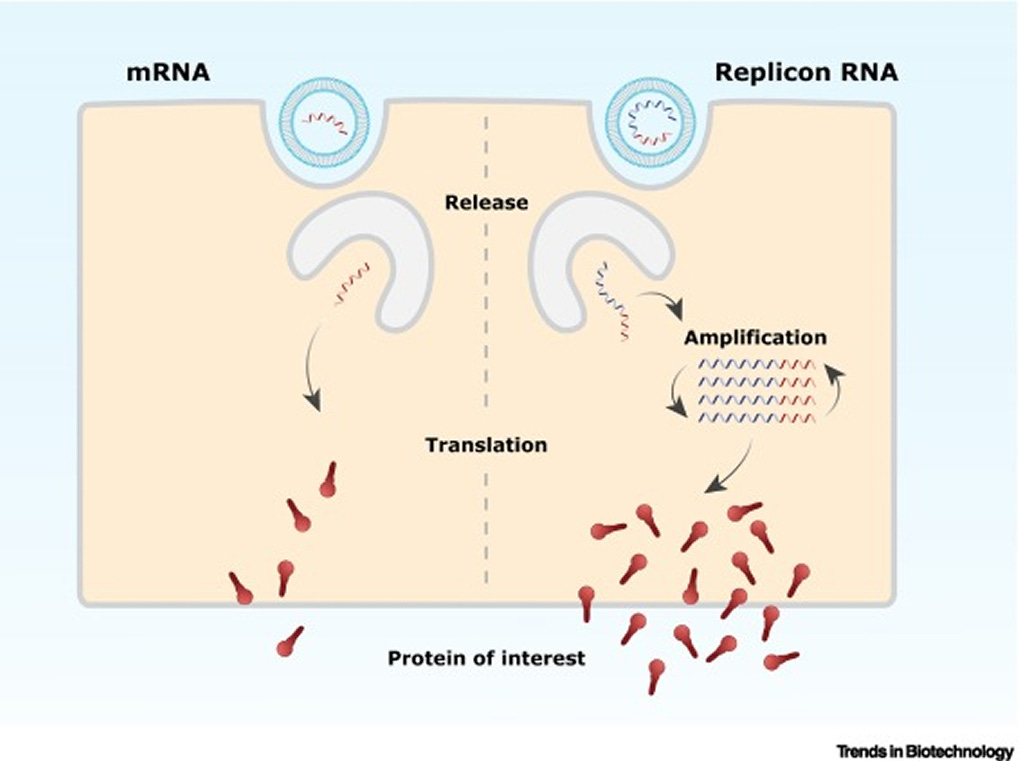mRNA Vaccines in Farm Animals: Pork, Beef, Shrimp. Self-amplifying mRNA Vaccines for Livestock
Cattle & swine outbreaks "anticipated", Australia building mRNA capacity, 9 articles reviewed

All Global Research articles can be read in 51 languages by activating the “Translate Website” drop down menu on the top banner of our home page (Desktop version).
To receive Global Research’s Daily Newsletter (selected articles), click here.
Visit and follow us on Instagram at @globalresearch_crg and Twitter at @crglobalization.
Articles reviewed:
- Sep.5, 2023 – Oral mRNA vaccines to be used in shrimp
- July 12, 2023 – CBC – We need to talk about mRNA vaccines in meats
- June 16, 2023 – TriState Livestock News – mRNA vaccines in meat animals
- June 8, 2023 – Scientific American – mRNA vaccines (by David Verhoeven)
- June 7, 2023 – Canadian Cattlemen – mRNA vaccines in cattle
- May 2, 2023 – Australia funds 5 year project for emergency cattle mRNA jabs
- April 19, 2023 – Pork Magazine – mRNA vaccine misinformation
- Aug 9, 2022 – Genvax Tech News on self-amplifying mRNA vaccines for swine
- Merck’s SEQUIVITY RNA Vaccine in swine
Sep.5, 2023 – Oral mRNA Vaccines to be used in shrimp
- Israeli company raised $8.25 million venture capital to mRNA vaccinate shrimp
- “Oral delivery is the holy grail of aquaculture health development due to the impossibility of vaccinating individual shrimp”
- Shrimp, one of the most widely consumed seafood products globally, in particular, are very susceptible to disease due to their lack of adaptive immune systems, and there are currently no products available that address shrimp disease today
- company’s first mRNA product is a feed supplement to enhance resistance to viral infections in shrimp, with the initial application targeting White Spot Virus (WSSV), which causes an annual loss of around $3 billion and a 15 percent reduction in global shrimp production
- “Aquaculture is critical for the sustainable supply of marine protein”
- “ViAqua’s platform technology will enable the company to move beyond WSSV to address numerous other diseases in aquaculture”
- “ViAqua produces its capsule products using commercial, industrial processes and is scaling production to take its first product to market. With plans to begin production in India at the beginning of 2024”
July 12, 2023 – CBC
- “There haven’t been studies on the side effects of humans eating animals that have been vaccinated with an mRNA vaccine, but there’s no evidence to show that there would be any.” – Shayan Sharif, Ontario Veterinary College, Guelph
- Mike McMorris, the chief executive officer with Livestock Research Innovation Corporation explained that a world without vaccines for livestock would threaten our food security: it’d mean more livestock deaths, resulting in lower supply and higher prices at the grocery store.
June 16, 2023 – Tri-State Livestock News
- United States has not approved mRNA injections in cattle, but they are in use on a limited basis in swine.
- the dilemma for beef is that the U.S. is importing more and more beef from many different countries, some of which either already are or plan to begin using mRNA in cattle for such cattle diseases as foot-and-mouth disease and lumpy skin disease.
- US Cattlemen’s Association News Release: “Currently, there are no mRNA vaccines licensed for beef cattle in the U.S. Since little is known about the technology, our organization will be forming a task force to develop a fact- and science-based assessment of the issue.”
- USDA states, “Withdrawal times are intended to ensure meat, milk, or other products for human consumption from the vaccinated animal are free from adjuvant or vaccine organism contamination.” This means tests are done to determine the length of time after the vaccine is given when no trace of the vaccine can be identified in any part of the animal
- Natural mRNA is degraded in minutes to hours
- Risks of mRNA vaccines in animals:
- Altered mRNA engineered for vaccines: “The estimate is that half of the mRNA from a vaccine is gone in about 20 hours, and completely destroyed within a few days.”
- “cooking of meat and pasteurization of milk make it highly unlikelythat we would be exposed to any small remnant of mRNA livestock vaccine.”
- “Add to that our digestive system is also designed to defend us against pathogens and the possibility further declines.”
June 8, 2023 – Scientific American (by David Verhoeven)
- Idaho introduced a bill that would make it a misdemeanor to administer any type of mRNA vaccine to any person or mammal, including COVID-19 vaccines
- Missouri bill would have required the labeling of animal products derived from animals administered mRNA vaccines but failed to get out of committee in April
- Arizona and Tennessee have also proposed labeling bills
- Traditional vaccines:
- inactivated vaccines contain a killed version of a pathogen (often don’t produce strong enough immune response)
- live attenuated vaccines contain a weakened version of a pathogen (can revert back to full pathogenic form or mix with other pathogens and become new vaccine resistant ones)
- subunit vaccines that contain one part of a pathogen (often don’t produce strong enough immune response)
- animal vaccines take three or more years from development to licensure by the U.S. Department of Agriculture
- Claimed advantages of mRNA: can be produced quickly
- Merck’s Sequivity is currently the only RNA vaccine licensed for use in animals, and it is available by prescription to protect against swine flu in pigs (doesn’t use modified nucleotides or lipid nanoparticles).
- Claim about ingesting mRNA:
- animal vaccine manufacturers must determine the withdrawal period in order to obtain USDA approval. This means any component of a vaccine cannot be found in the animal prior to milking or slaughter
- Between the mandatory vaccine withdrawal period, flash pasteurization for milk, degradation on the shelf and the cooking process for food products, there could not be any residual vaccine left for humans to consume
June 7, 2023 – Canadian Cattlemen – mRNA vaccines in cattle
- No mRNA vaccines are approved for use in beef cattle in North America today
- However, mRNA vaccines are being tested for viral diseases such as foot-and-mouth disease and lumpy skin disease
- main benefit of mRNA vaccines is that they can be developed quickly
- apparent speed of development led many people to question their safety, mRNA vaccine delivery systems, as well as their safety and effectiveness, have been studied for over 30 years.
- In Canada, veterinary biologics (which include vaccines) are regulated by the Canadian Food Inspection Agency. The veterinary biologics regulatory program is administered by the Canadian Centre for Veterinary Biologics, which oversees the manufacturing, testing, labelling, import, export, distribution and use of vaccines for domestic livestock.
- Although there are no mRNA vaccines approved for use in beef cattle, an RNA-based vaccine technology (SEQUIVITY®) is now available in the U.S. for use in swine.
- Like all vaccines for beef cattle, mRNA vaccines will have a required withdrawal period prior to processing. As mRNA has a short life, it will not remain in the body for long or produce long-term effects. An mRNA vaccine does not genetically modify the animal, nor pass from one animal to another. The mRNA vaccine is not passed into meat or any other animal product.
May 2, 2023 – Australia funds 5 year project for mRNA emergency animal jabs
- Meat & Livestock Australia has funded a project to produce mRNA vaccines that can be rapidly mass produced in Australia in the event of a lumpy skin disease (LSD) or other exotic disease outbreak in cattle
- “This will enable capacity for rapid mass production of a vaccine for LSD in the event of an outbreak.”
- “The LSD vaccine construct is now being tested for efficacy in animals. By the end of this year, we will know if this vaccine will work in ruminants”
- “The establishment of the capacity to produce a vaccine for LSD is the priority that will provide the Australian cattle and other ruminant industries with insurance against an imminent biosecurity threat”
- “The establishment of an mRNA production capability and development of an LSD vaccine will be the initial flagship, stand-alone project within a larger program: Adoption of RNA technology to rapidly produce vaccines for emergency animal disease.”
- “The proposed over-arching five-year program will secure licensed mRNA vaccine technology and activate an independent livestock vaccine development and production pathway based on newly established scientific capacity and infrastructure. This will ultimately result in the stored vaccine constructs produced from this project to respond quickly to incursion of multiple diseases through rapid production of vaccines.”
April 19, 2023 – Pork Magazine – mRNA vaccine misinformation
- According to USDA spokesperson, Marissa Perry says, “There is no requirement or mandate that producers vaccinate their livestock for any disease. It is a personal and business decision left up to the producer and will remain that way
- “mRNA vaccines does not alter the animal’s genes in any way.” – Dr.Kevin Folta, molecular biologist at University of Florida
- Benefits of mRNA vaccines: more flexibility and faster response to new disease
- “Traditional vaccines require large amounts of a virus to be raised and purified before being injected to elicit an immune response”
- In pork production specifically, researchers are working with mRNA vaccines that will work this way against porcine reproductive and respiratory syndrome (PRRS), which is a viral disease that causes economic loss totals around $664 million per year in the US.
- use of mRNA technology adds another tool to the toolbox, which may be helpful in combating diseases, such as African swine fever (ASF), avian influenza and other food-animal diseases.
- Risks of mRNA vaccines: “As seen with the COVID-19 vaccines, in rare cases, people experienced side effects from the vaccine. However, Folta is encouraged by the initial results in livestock.”
- “If you look in animals where these vaccines have been used, there have been no unusual effects noted. Everything potentially has risk, but it’s monitored, and especially in large animal populations, we can look very carefully at that for surveillance,” Folta explains.
Aug 9, 2022 – Genvax Tech News
- GenVax Tech secured $6.5 mil to produce self-amplifying mRNA (saRNA) vaccine in swine
- “This funding moves the company a step forward to USDA and international regulatory approval of its vaccines in anticipation of any foreign animal disease outbreak” Genvax said in a release.
- Genvax’s technology involves inserting a specific transgene or “gene of interest” matched to the variant strain into the platform. The saRNA then generates an antibody response without requiring the whole pathogen to be matched to the circulating strain.
- In April 2022, Genvax received more than $145,000 in grant funding from the USDA-Agricultural Research Services Plum Island Animal Disease Center and the Foundation for Food and Agriculture Research (FFAR) to develop a saRNA vaccine for African Swine Fever (ASF) virus
- ASF is a deadly virus of pigs that can cause up to 100% mortality in pigs and could decimate the income of U.S. pork producers and force layoffs, significantly reducing rural employment.
- Economic models estimate the worst case scenario of an ASF outbreak in the U.S. would result in a $50 billion loss to the domestic pig industry.
Merck’s SEQUIVITY RNA vaccine in pork
- SEQUIVITY uses electronic gene sequencing to generate RNA particles that, when injected into an animal, provide instructions to immune cells to translate the sequence into proteins that act as antigens
- The RNA is transported inside of a disabled virus, which acts like a capsule. This combination of RNA inside of this viral capsule is called the RNA Particle and it is injected into the pig. These particles are taken up by specific cells of the pig’s immune system known as dendritic cells. The dendritic cells translate the swine flu RNA into a swine flu protein, which they then display at their surface
- According to Merck, their RNA participle technology allows for the development of a “safe and flexible” custom swine flu vaccine in only 8 to 12 weeks
- Vaccines available: PCV2, PCV3, Rotavirus, Sapovirus, Influenza A, Porcine epidemic diarrhea (PED)
SUMMARY…
There are currently no mRNA vaccines being used in livestock in North America.
Shrimp – An Israeli company is developing an oral mRNA feed supplementto vaccinate shrimp and will begin production in India in 2024.
Cattle – There are no mRNA vaccines approved in US or Canada.
- Australia has launched a 5-year project to build capacity to rapidly mRNA vaccinate all cattle for Lumpy skin disease virus (LSDV) or “other exotic disease outbreak”
- launched in March 2022 and a govt press release is here
- Saudi Arabia is researching an mRNA vaccine for cattle LSDV
Pigs – one approved RNA product in Canada and USA – Merck’s SEQUIVITY – uses RNA transported inside a disabled virus capsule (no pseudouridine modifications, no lipid nanoparticles)
- A US company Genvax Tech raised $6.5 mil to develop a “self-amplifying mRNA vaccine” for swine flu
- Genvax anticipates a “foreign animal disease outbreak” that could result in $50 billion loss to domestic pig industry” (oddly specific).
SELF-AMPLIFYING mRNA (June 14, 2023, Comes et al)
- “The next step in mRNA vaccine design is the application of viral-based self-amplifying mRNAs (replicons) that provide long-lasting humoral and cellular immune responses upon single, low-dose immunization.”
- “Replicons encode their own replication machinery to boost their copy numbers directly after administration in target cells, which dramatically lowers the required initial mRNA dose and may consequently reduce adverse effects in individuals.”
MY TAKE…
There are five very disturbing aspects of the current state of mRNA vaccination of livestock:
- The scientists are already lying about safety of mRNA vaccinating livestock. They lie about the duration of pseudouridine mRNA lasting only a few days (it can last 4 weeks), they lie that it can’t “alter genes” or integrate into our genome (it can), they lie about strict quality control (no mention of risks of DNA plasmid contamination), they lie about safety of lipid nanoparticles, they lie about mRNA’d meat being safe to consume, they lie about no shedding, they lie about mRNA not ending up in meat or milk. They seem to be lying about everything.
- Australian government has a most disturbing project – building capacity to mRNA vaccinate all cattle in the event of an “outbreak”, which they are probably planning to create themselves. This is a 5 year project and there is clearly some kind of a plan to eliminate all beef consumption in Australia.
- Replicon RNA (self-amplifying mRNA) vaccines for swine, is the stuff of nightmares – with COVID-19 mRNA vaccines we had uncontrolled spike protein production, but with self-amplifying RNA you get both uncontrolled mRNA replication AND uncontrolled spike protein production, and much more of it.
- Genvax anticipates a “foreign animal disease outbreak” that could result in $50 billion loss to domestic pig industry” while the Australian government anticipates a cattle “(LSDV) or other exotic disease outbreak”. I find this particularly odd and disturbing, that there would be such fervent “anticipation” of such an outbreak.
- Oral mRNA vaccinating our seafood through an artificial “mRNA feed supplement” for shrimp and other seafood is a very bad sign of things to come.





No comments:
Post a Comment